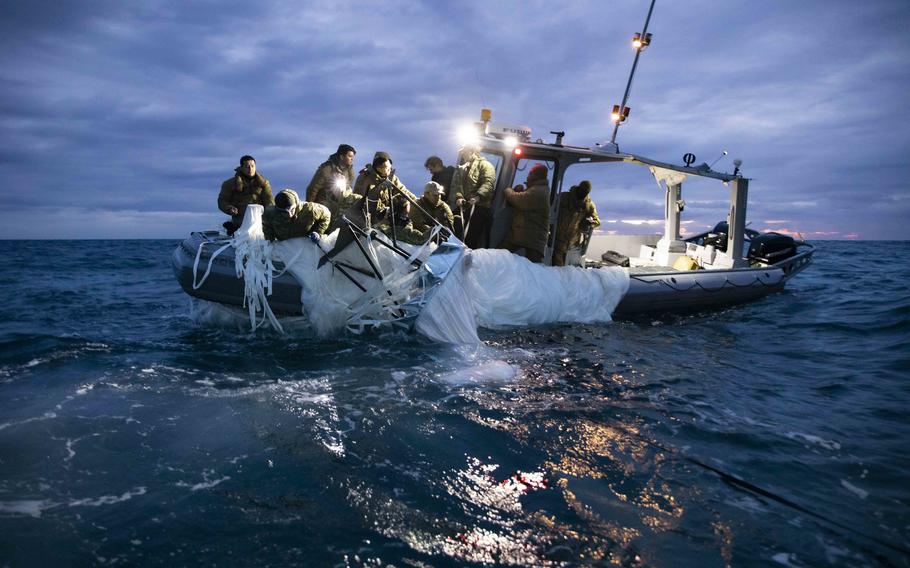
Sailors assigned to Explosive Ordnance Disposal Group 2 on Feb. 5, 2023, recover portions of a high-altitude Chinese surveillance balloon off the coast of Myrtle Beach, S.C. A U.S. fighter jet shot down the balloon over U.S. territorial waters on Feb. 4, 2023. (Tyler Thompson/U.S. Navy)
WASHINGTON — The U.S. military waited to shoot down a Chinese spy balloon until it was over the Atlantic Ocean partly because recovery efforts in Alaskan waters would be treacherous, Defense Department officials told senators Thursday.
The ongoing debris collection from the downed balloon in the shallow waters near South Carolina is easier and safer than it would have been in Alaska, where frigid water off the Aleutian Islands quickly plunges from depths of 150 feet to more than 18,000 feet, officials said told members of the Senate Appropriations Committee.
“A key part of the calculus for this operation was the ability to salvage, understand and exploit the capabilities of the high-altitude balloon,” said Melissa Dalton, assistant secretary of defense for homeland defense and hemispheric affairs. “If we had taken it down over Alaska, it would’ve been a very difficult recovery operation.”
Dalton and other defense officials defended the Pentagon’s decision-making to an angry panel of senators Thursday that repeatedly questioned why a Chinese surveillance balloon was allowed to traverse the continental U.S. for days.
“You guys have to help me understand why this baby wasn’t taken out long before,” said Sen. Jon Tester, D-Mont., chairman of the appropriation committee’s defense subpanel.
The balloon initially breached the U.S. over Alaska on Jan. 28 before traveling over Canada and reentering the U.S. over Idaho on Jan. 31. An F-22 fighter jet downed the balloon with a missile as it hovered over 47-foot water 6 miles off the coast of South Carolina on Feb. 4.
Sen. Lisa Murkowski, R-Alaska, admonished officials for taking no action when the balloon first violated U.S. air space over her state, describing Alaska as “the first line of defense for America.”
Alaska is one of the most militarized U.S. states, with more than 20,000 service members and an Air Force base that is set to host more fifth-generation fighter jets than any other location in the world. It is also at the forefront of the Pentagon’s strategy to challenge increasingly aggressive military posturing by Russia and China in the Arctic region.
“If you’re going to have Russia coming at you, if you’re going to have China coming at you, you know exactly how they will come,” Murkowski said. “They come up and they go over Alaska. Sometimes they go on the top, sometimes they go straight across, but Alaska is it.”
The military did not deem the Chinese balloon, which was about 200-feet tall and carrying a jetliner-size payload, to be of hostile intent when it was over Alaska, Lt. Gen. Douglas Sims, director of operations of the Joint Staff, said Thursday. The balloon’s path through the state did not take it near sensitive infrastructure or impact intelligence gathering, he said.
As the balloon flew into continental U.S. territory, the military took steps to protect sensitive sites, including covering up certain facilities, according to Dalton.
“As we reconstruct the path, we are not concerned with intelligence gathering in Alaska,” Sims said.
Downing the balloon over either Alaskan land or water would have been risky for civilians and military personnel, officials said. The military could not determine through mapping what damage the balloon would cause on the ground, he said, while deep and icy water in the Bering Sea would be dangerous for recovery efforts.
“Throughout this, Gen. [Glen] VanHerck and the men and women who were serving under him had American safety in mind and if at any moment had it presented some sort of intent to hurt Americans, they would’ve taken that balloon out of the sky,” Sims said, referring to the commander of North American Aerospace Defense Command and U.S. Northern Command.
The USS Carter Hall, a Harpers Ferry-class dock landing ship, is continuing to collect debris from the downed balloon off the South Carolina coast and the USNS Pathfinder, an oceanographic survey ship, is using sonar to map and search the ocean floor, Dalton said.
A damage assessment is expected to take days to weeks, she said.
Senators on Thursday expressed concern that China has been emboldened by the delayed response of the U.S. and will keep seeing how far it can push boundaries before the U.S. takes meaningful action.
“It seems to me, the clear message to China is we’ve got free range in Alaska because they’re going to let us cruise over that until it gets to more sensitive areas,” Murkowski said. “At what point do we say a surveillance balloon, a spy balloon coming from China is a threat to our sovereignty? It should be the minute it crosses the line, and that line is Alaska.”